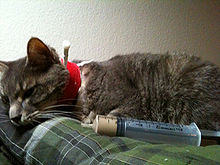
Cats may receive appetite stimulants even if they are on a feeding tube. How to Treat Cats With Liver Disease 2006 Publications International Ltd.

This is were the body attacks the fat in the liver for engery.
How long do cats live with fatty liver disease. With prompt treatment 80 to 90 percent of cats fully recover from fatty liver disease. Treatments typically last three to six weeks. The veterinarian will need to monitor the cat during this time with follow-up appointments to ensure that recovery is occurring.
This takes an average of six to seven weeks. Therefore a method of feeding must be used that allows you to feed your cat at home. This disease is treatable with aggressive nutritional support until a.
If your cat was just diagnosed with hepatic lipidosis fear not. While it sounds scary hepatic lipidosis simply means that there is inappropriate fat infiltration into the liver. Often known by the laymens term fatty liver this disease occurs when cats especially obese cats go without food for a few days.
Fatty liver disease also known as hepatic lipidosis or fatty liver syndrome is a disease that affects a cats liver. It is the most common acquired liver disease in cats and it can be life threatening. In most cases it is the consequence of anorexia and dramatic weight loss in overweight cats.
When active liver tissue is swamped with fat the liver can no longer function and goes into liver failure. When fatty liver disease hepatic lipidosis does happen the cat needs intensive care and force-feeding in order to switch off harvesting energy from fat and clean out the liver. Most human medications are toxic to cats.
However if your cat has been diagnosed with liver failure and is still free of any major symptoms you could have anywhere from 6-8 months with your feline friend. When it comes to the question of how long your cat will live with their liver failure its best to have an in depth conversation with your vet on their specific prognosis. Cats may receive appetite stimulants even if they are on a feeding tube.
The goal of course is to get them eating on their own and to make them not need the feeding tube. It can take a few days or a few weeks for the appetite stimulants to take effect depending on the cat and the severity of the liver disease. How to Treat Cats With Liver Disease 2006 Publications International Ltd.
Liver problems have similar symptoms to other cat sicknesses so it will take a discerning eye to read the signs. The liver plays an important role in metabolism and taking toxins and other unneeded compounds out of the blood. Cats with fatty liver disease are often not eating or are not eating nearly the amount that they were before.
Lethargy depression and not acting playful are all signs that are seen in cats with fatty liver disease. 70 of cats affected by fatty liver disease will have jaundice. To prevent fatty liver disease you need to make sure your cat isnt too fat but also that theyre eating an appropriate amount.
A decreased or sudden halt in eating is almost always seen in cats with this disease. You shouldnt think that you can out stubborn your cat by waiting for them to get hungry and start eating again. Feline hepatic lipidosis also called fatty liver disease is an abnormal accumulation of fat usually triglycerides in the liver of a cat.
It is the most common liver disease diagnosed in cats in North America. Anything that causes a significant decrease in food intake can lead to this condition. Obesity is a known risk factor and obese middle-aged adult cats are most often affected.
Although the disease can be life-threatening if the cat receives treatment immediately the survival rate of fatty liver disease is promising. According to Cat Watch 85 percent of cats who survive the first 96 hours of feline hepatic lipidosis treatment will go on to a full recovery. Signs of liver disease in cats are often very vague such as.
Depending on the cause and severity other signs such as a fever increased thirst or vomiting may also be seen. In some cases liver disease may cause fluid to accumulate in the abdomen ascites. And with more advanced or severe disease jaundice.
Diseases elsewhere in the body can also affect the livers function. Fortunately liver disease can be effectively managed and progression limited. Many cats go on to live happily years after their diagnosis.
Proper nutrition and continuous dialogue with your veterinarian are. In the CPT chart a score of 5-6 indicates class A and the survival rate for the next two year is 80. A score of 7-9 indicates class B and a 60 survival rate for the next two years.
A score of 10-15 indicates class C and a 35 survival rate for the next two years. A cat can not go two weeks with out eating. They will get Hepatic Lipidosis or fatty liver disease quickly as two days.
This is were the body attacks the fat in the liver for engery. This results in more sickness now causing the cat to not eat because the HL is making them feel sick. Please research Hepatic Lipidosis or fatty liver disease.